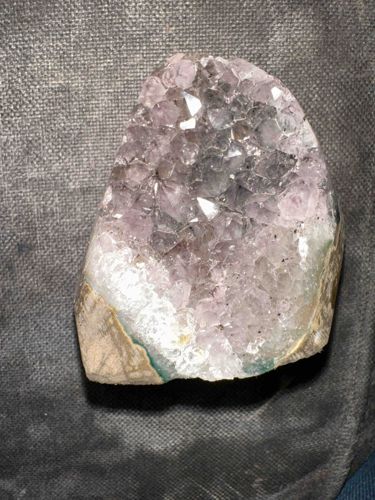
Amethyst Geode Section
This item is an amethyst geode, presenting as a partial nodule or 'cut-open' formation revealing a crystalline interior. Physically, it is an irregularly shaped specimen, likely weighing several pounds given its apparent size. The exterior, or matrix, of the geode is rough and earthy, displaying a mix of light brown to off-white tones with natural texture, indicative of the host rock, which appears to be a natural basalt or similar volcanic rock often associated with amethyst formation. A notable feature is the distinct white and greenish-blue band visible along portions of the geode's rim and surrounding the crystalline cavity, which is characteristic of agate or chalcedony layers that often form before quartz crystallization in geodes. The prominent feature is the sparkling amethyst crystal cavity, which occupies the majority of the visible area. The crystals are varied in size, mostly small to medium, forming a druzy surface. Their color ranges from a translucent pale lilac to a deeper, more concentrated purple, suggesting natural untouched coloration, rather than heat-treated material. Some crystals exhibit excellent clarity and sharp terminations, reflecting light brightly, while others appear slightly more opaque or less defined. There are no obvious signs of significant damage such as large chips or cracks, though typical minor inclusions or variations in crystal growth are present as part of its natural formation. The overall quality appears good for a natural specimen, showcasing a healthy growth of amethyst crystals within its geological housing. It is a natural formation, likely millions of years old, rather than a manufactured item. The craftsmanship involves the careful cutting and exposing of the geode's interior, likely done to enhance its aesthetic appeal for display.
AI-Generated Appraisal Disclaimer
Estimated Value
$400-600
Basic Information
Category
Mineral Specimen / Geode
Appraised On
November 29, 2025
Estimated Value
$400-600
Item Description
This item is an amethyst geode, presenting as a partial nodule or 'cut-open' formation revealing a crystalline interior. Physically, it is an irregularly shaped specimen, likely weighing several pounds given its apparent size. The exterior, or matrix, of the geode is rough and earthy, displaying a mix of light brown to off-white tones with natural texture, indicative of the host rock, which appears to be a natural basalt or similar volcanic rock often associated with amethyst formation. A notable feature is the distinct white and greenish-blue band visible along portions of the geode's rim and surrounding the crystalline cavity, which is characteristic of agate or chalcedony layers that often form before quartz crystallization in geodes. The prominent feature is the sparkling amethyst crystal cavity, which occupies the majority of the visible area. The crystals are varied in size, mostly small to medium, forming a druzy surface. Their color ranges from a translucent pale lilac to a deeper, more concentrated purple, suggesting natural untouched coloration, rather than heat-treated material. Some crystals exhibit excellent clarity and sharp terminations, reflecting light brightly, while others appear slightly more opaque or less defined. There are no obvious signs of significant damage such as large chips or cracks, though typical minor inclusions or variations in crystal growth are present as part of its natural formation. The overall quality appears good for a natural specimen, showcasing a healthy growth of amethyst crystals within its geological housing. It is a natural formation, likely millions of years old, rather than a manufactured item. The craftsmanship involves the careful cutting and exposing of the geode's interior, likely done to enhance its aesthetic appeal for display.
Related Tags
Get Your Items Appraised
Instant estimates of your treasures with AI-powered instant appraisals